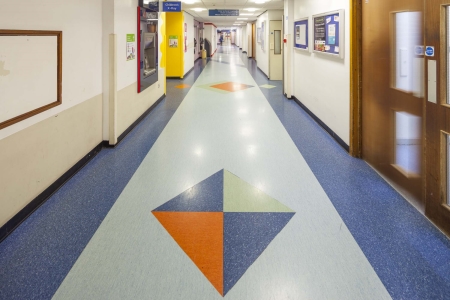NHS England has identified a £30billion shortfall in the NHS budget come 2020. To tackle this, the Government has pledged up to £8billion, with the remaining £22billion set to come from productivity improvements and cost savings.
Long term value, durability and flexibility are, therefore, of utmost importance when specifying flooring for the healthcare environment.
Neglecting to consider acoustic design, aesthetics, and hygiene and air quality standards compliance when selecting flooring can have a negative effect on occupant comfort
The flooring material selected is also fundamental to patient comfort and plays an influential role in patient recovery. Neglecting to consider acoustic design, aesthetics, and hygiene and air quality standards compliance when selecting flooring can have a negative effect on occupant comfort.
Acoustics
The healthcare sector has its own unique acoustic requirements. Sound affects us both physiologically and psychologically, and unwanted noise can increase blood pressure, heart rate, respiration rate and blood cholesterol levels.
The World Health Organization (WHO) recommends that the average sound level in general hospital areas should not exceed 30 dBA, but research indicates that it is not uncommon for measurements of 65-83 dB to be found in intensive care units. Evidently there is significant potential for improvement, especially when it comes to healthcare refurbishment projects.
Today we find flooring available with acoustic options that achieve an impact sound reduction of up to 20dB.
Specialist healthcare and dementia
It is widely recognised that the colours of an educational environment can affect the learning and memory performance of the occupant. We see similar findings when it comes to healthcare.
Our research into the design of dementia facilities indicates that some colours can encourage a sense of wellbeing and help create a setting that patients find reassuring, while other colours can cause behavioural problems. Colours also assist in zonal demarcation as solid and contrasting colours make it possible to distinguish between the different zones of the unit and make it easier for patients to orient themselves, for example by using an orangey tone for an activity zone. Using these findings we’re been able to advise Alzheimer’s facilities on colour selection in addition to offering multi-performance flooring options such as acoustic options and loose-lay.
Hygiene and air quality standards
WHO guidelines for indoor air quality indicate that indoor air pollution plays a significant role in the general state of health of people who spend a considerable amount of time indoors. Hospitals and healthcare facilities, therefore, have a particular duty to protect patients, staff and visitors, from air pollution, bio particles and airborne infection; especially when the WHO identifies children, elderly people and other vulnerable groups as being particularly at risk from biological and chemical indoor pollutants.
Research in 2013 by ASHRAE, the global society advancing human wellbeing through sustainable technology for the built environment, estimated that up to 20% of hospital infections may be attributed to airborne bacteria and viruses. The choice of flooring in the hospital environment can play a vital role in improving patient healthcare, and similar to colour, good air quality can assist in ensuring the psychological and physical wellbeing of inhabitants.
With healthcare and facilities managers understanding the importance of improving Indoor Air Quality (IAQ), specifying flooring with low Volatile Organic Compounds (VOC) emissions to meet current European standards is a priority.
VOCs are used in most products and are a large group of carbon-based chemicals that easily evaporate at room temperature into the air we breathe, the implications on patient healthcare being of potential concern. It is, therefore, imperative that any flooring specified has a low VOC emissions rate.
Heavy traffic, maintenance and refurbishment
Hospitals experience heavy traffic. This means it is essential the selected flooring is extremely durable and offers outstanding flexibility. Flooring that does not require wax or polish for life is ideal for high-traffic areas since these areas typically require more-intensive and frequent cleaning. Over a 10-year period, only around 10% of the cost incurred in the specification of flooring is the cost of the flooring product itself. The majority of the expense comes from the labour, energy, water and cleaning materials required for maintenance. Manufacturers offering easy low-cost maintenance flooring ultimately provide significant cost and time benefits.
With the right manufacturer, it is reasonable to expect flooring in a heavy traffic healthcare environment to maintain its appearance and properties well over a decade after application
In light of the increasing concern surrounding NHS funding that has arisen over the last five years, there is even more emphasis placed on ensuring that the materials, including flooring, selected for refurbishment projects meet NHS budget restraints without compromising on quality. With the right manufacturer, it is reasonable to expect flooring in a heavy traffic healthcare environment to maintain its appearance and properties well over a decade after application.
It is equally important that refurbishment projects cause as little disruption to the daily running of the hospital as is possible. We see manufacturers meet these criteria with flooring that can be easily applied to existing surfaces, with for example loose-lay and interlocking tiles options which contribute in reducing labour and material costs.
Sustainability
The NHS recognises the link between sustainability and public health as outlined in the Sustainable Development Management Plan . The plan’s primary focus is on reducing carbon emissions, but there is also significant emphasis on recycling and the potential for cost savings. In response hospital and facilities managers now expect flooring that is 100% recyclable and the market has duly provided.

If well specificied, floorings can have a lifespan of 10 years or more




